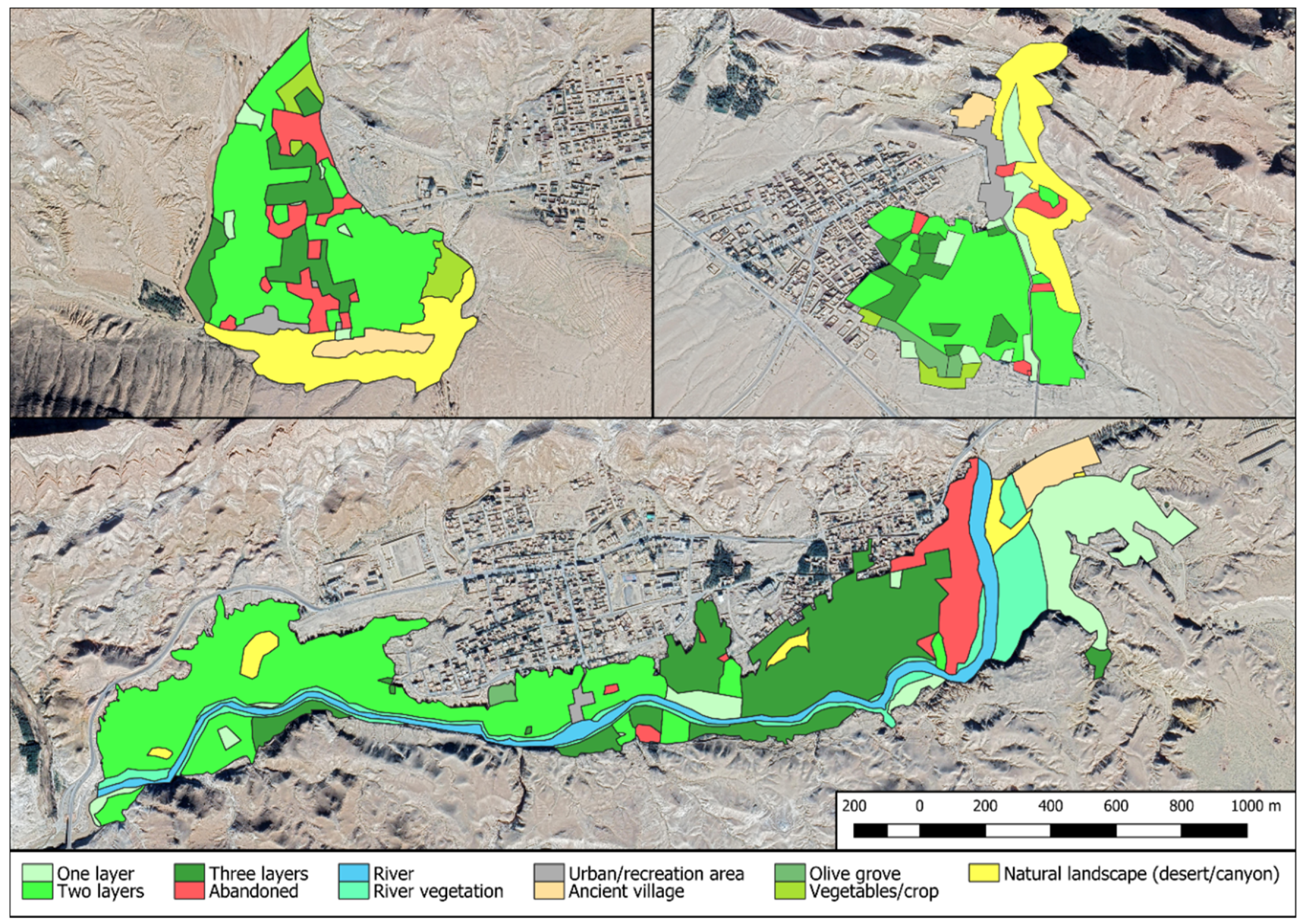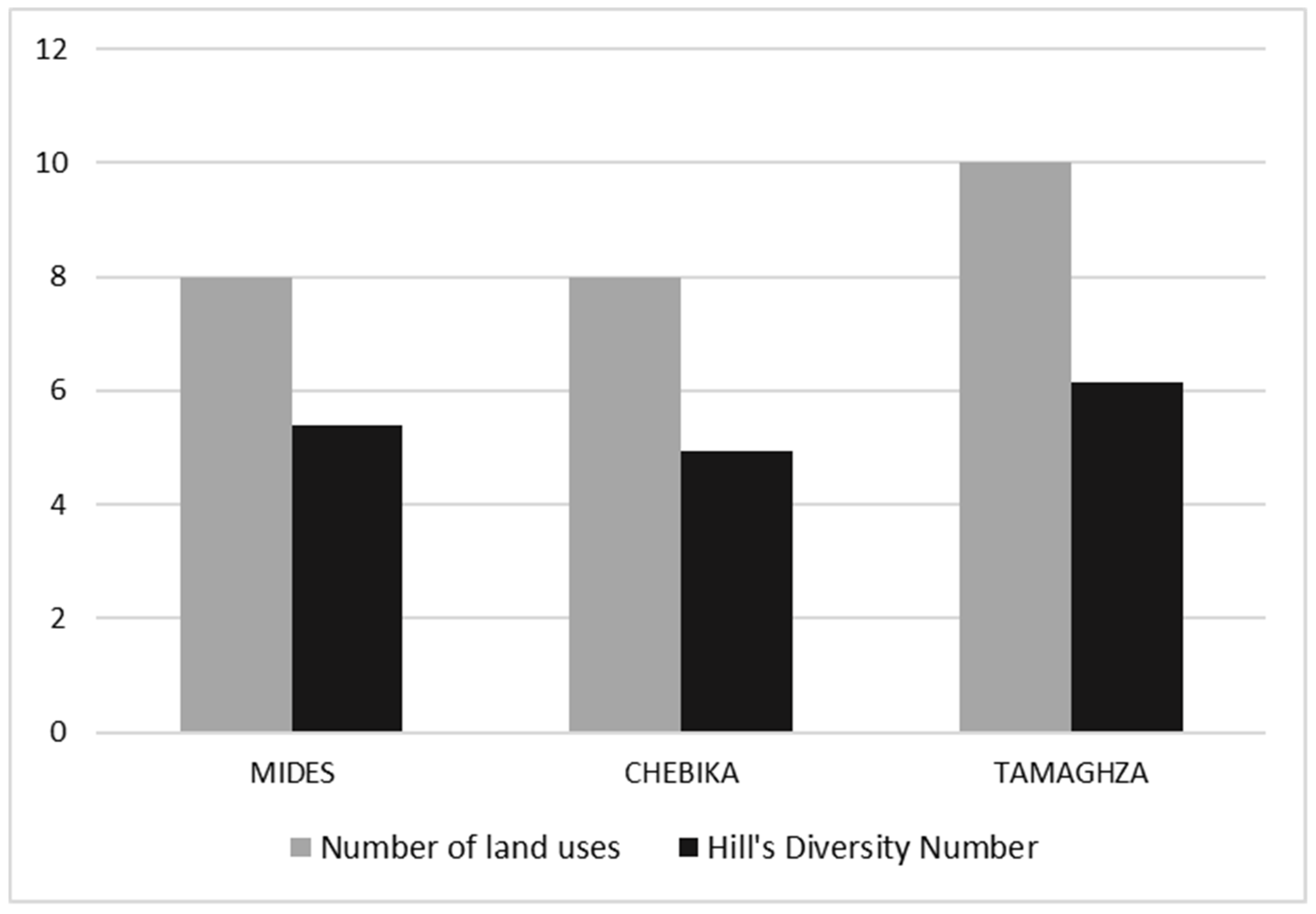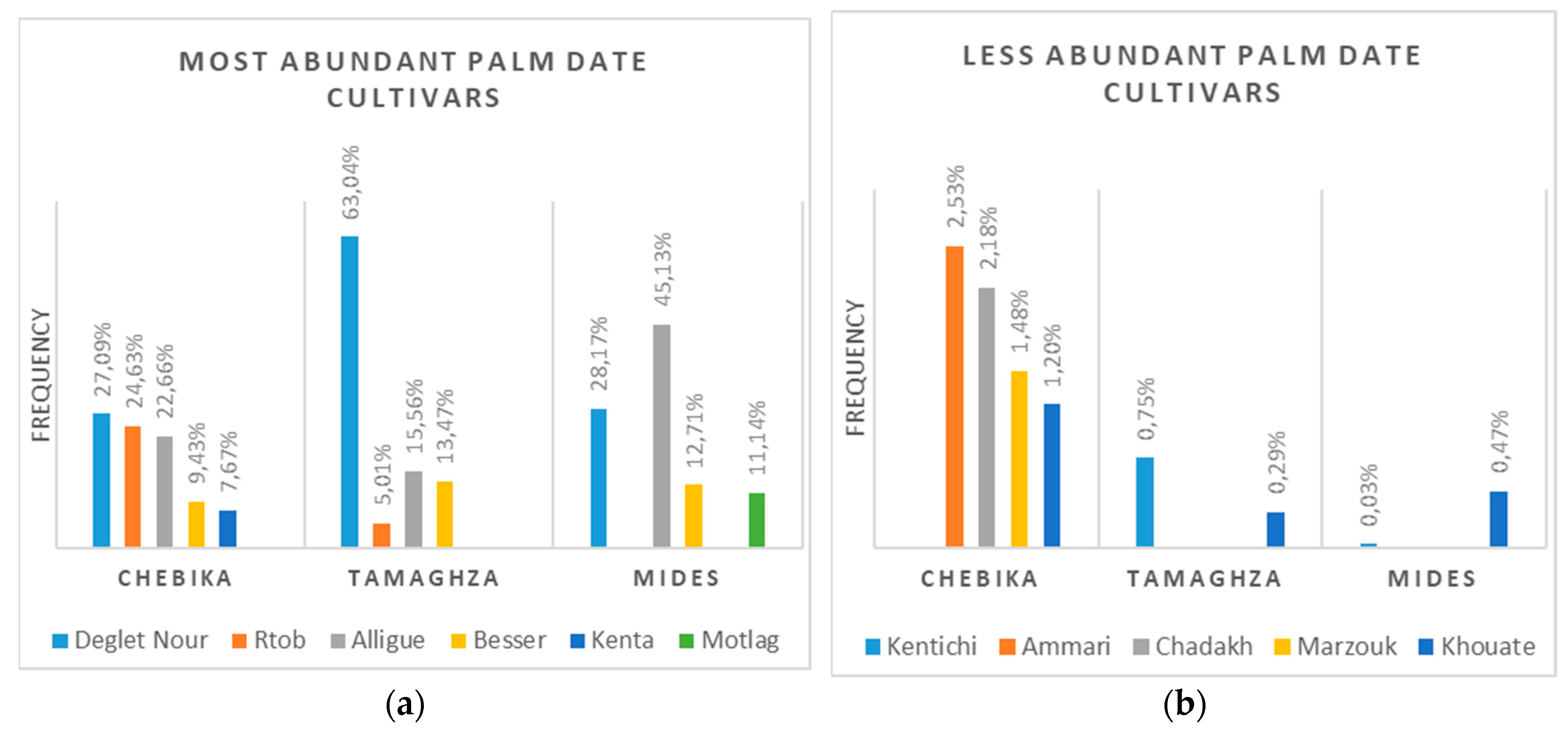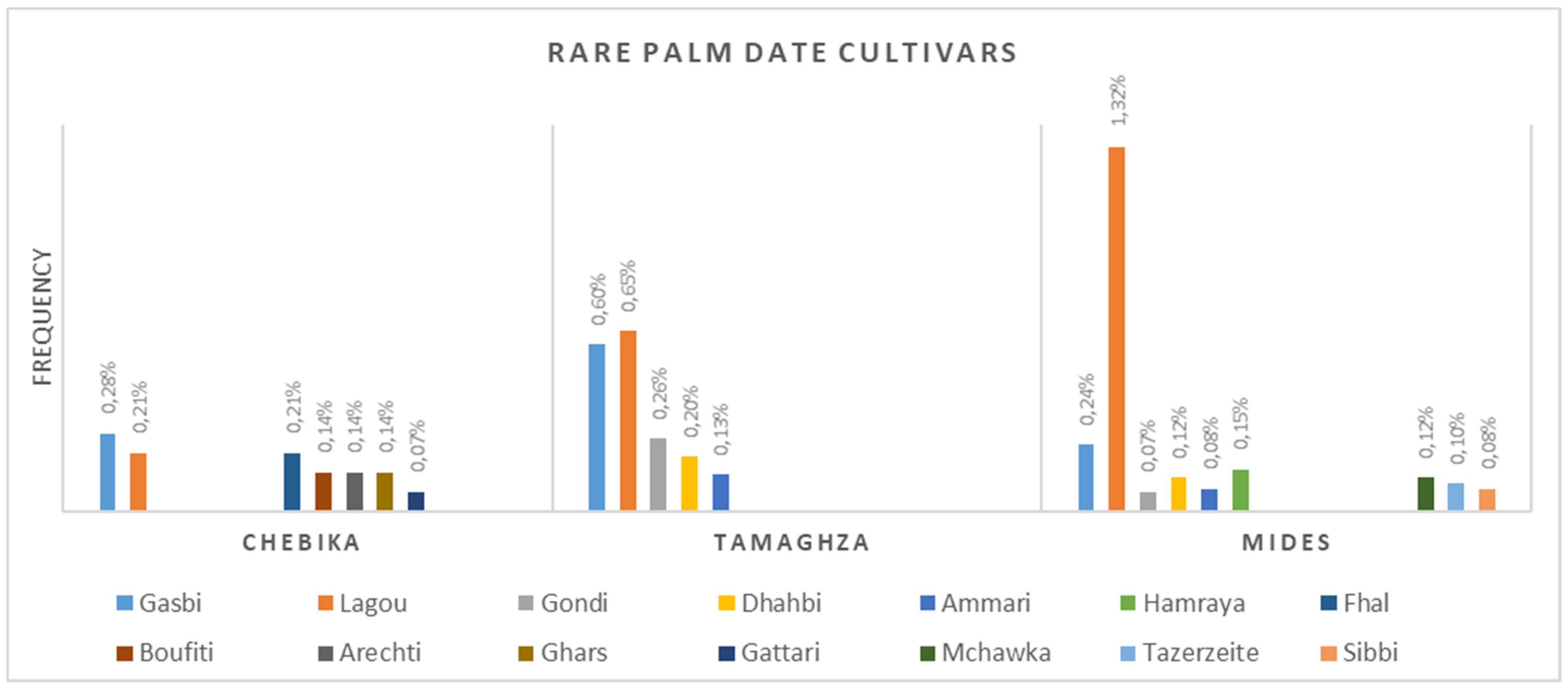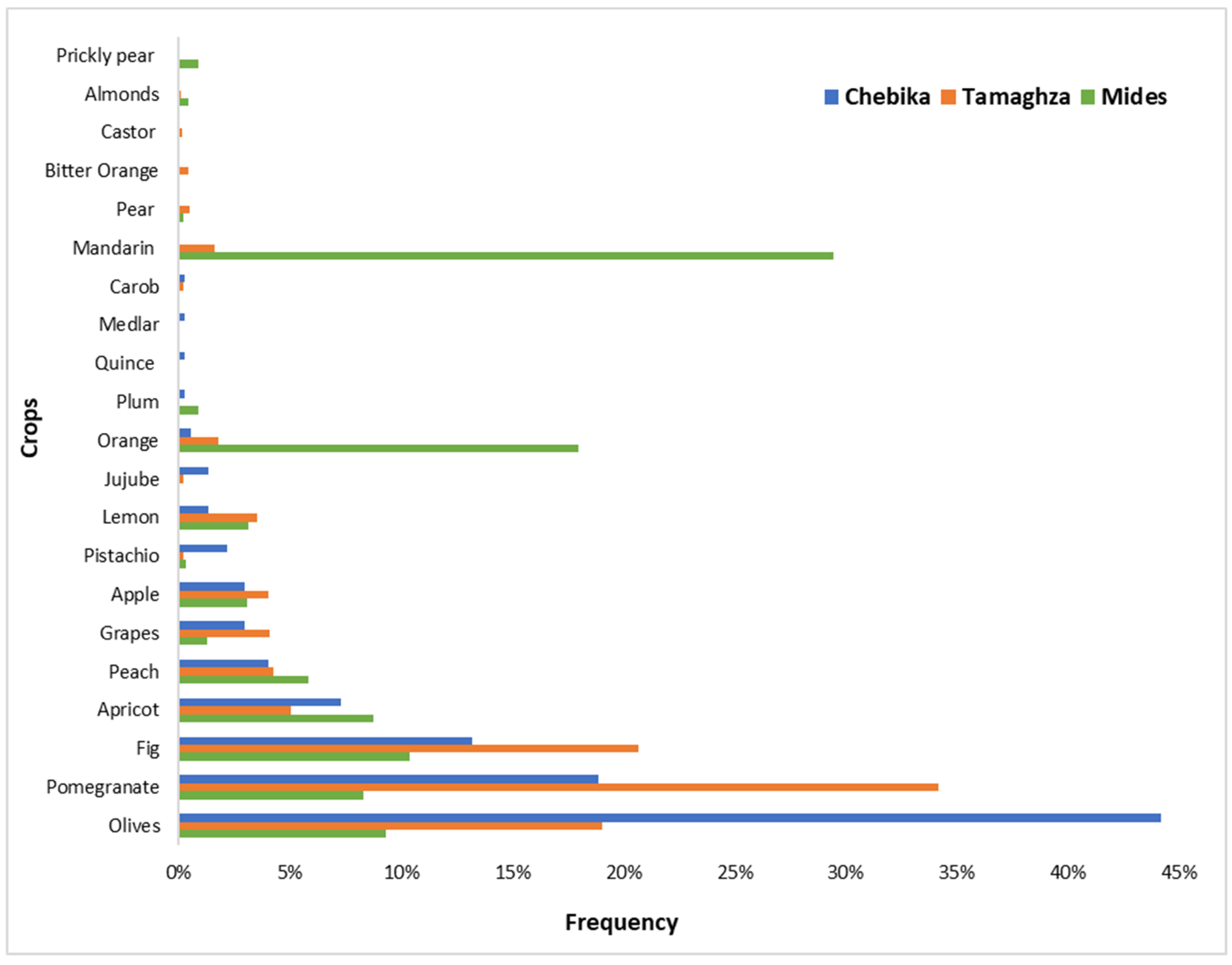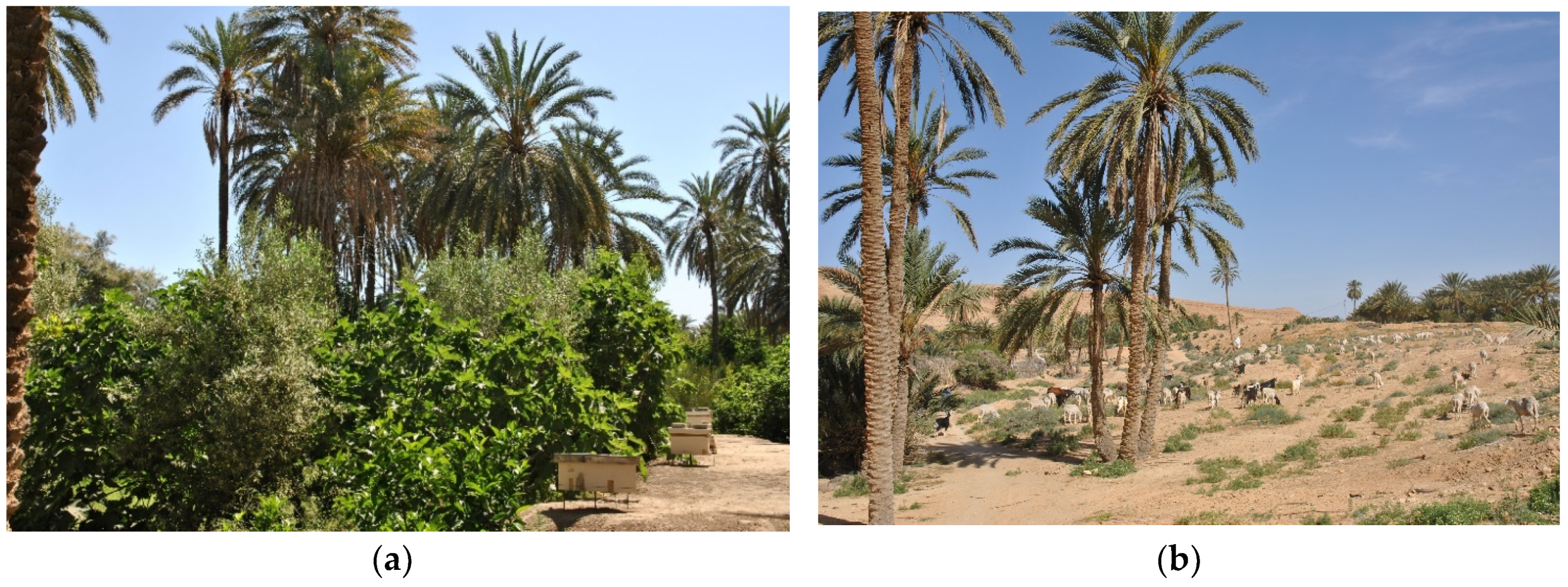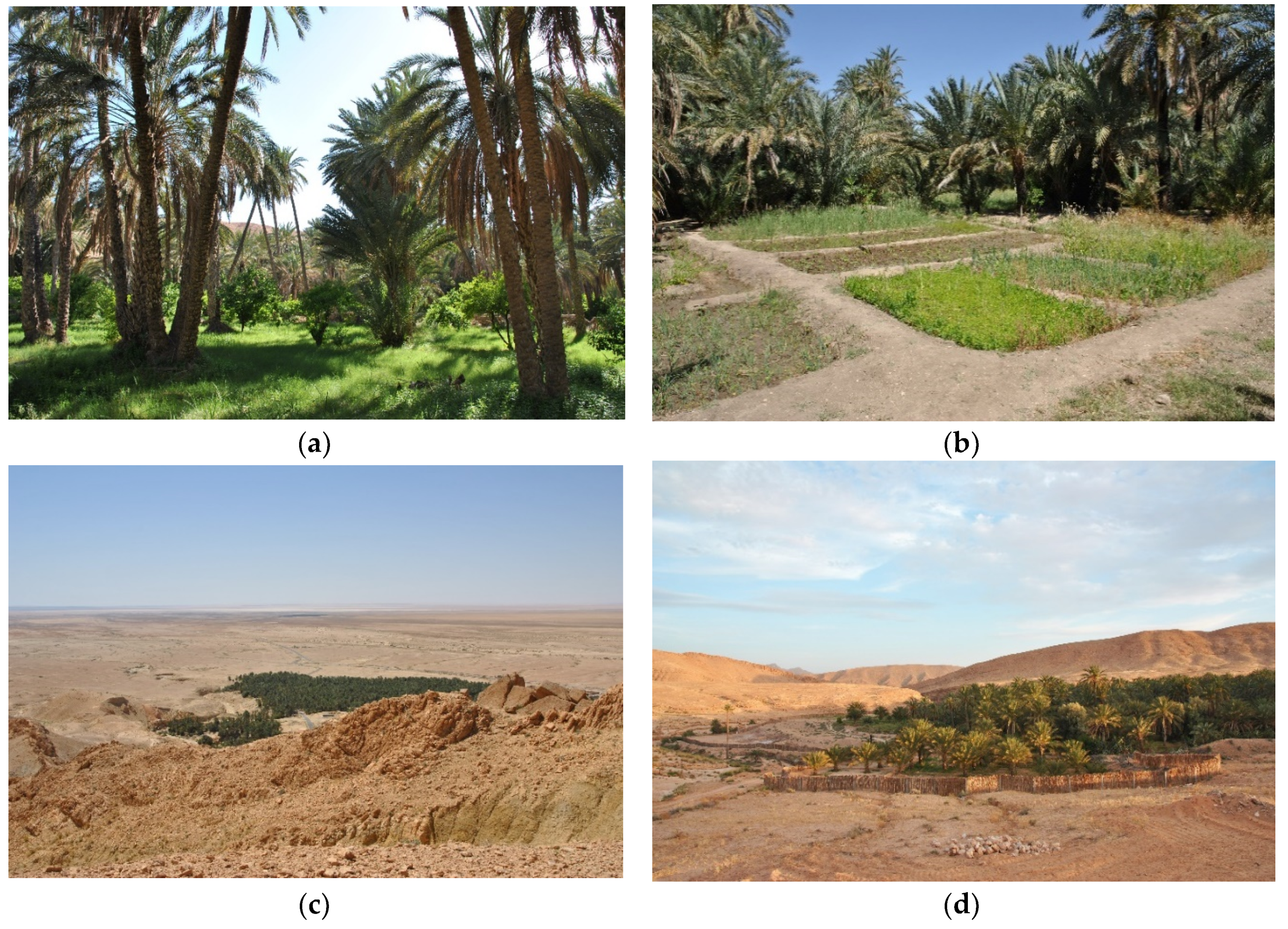3.1. Land Use and Irrigation System
Traditional agricultural activities are still widespread in the three oases, and even if they have a lot of features in common, some differences can be found related to land uses (
Table 2 and
Figure 2). The two-layer land-use system is the most common typology of cultivation, ranging from 32% in Tamaghza, to 42% in Chebika to 45% in Midès. The three-layer typology is more common in Tamaghza (24%), than in Midès (14%) or Chebika (10%) while the one-layer land-use system can be found mainly in Tamaghza and Chebika (respectively 13% and 10%), but it is rare in Midès (2%). Regarding other types of single cultivations: olives groves are more common in Chebika and are set in the south part, at the border of the oasis facing the desert; herbaceous cultivations (vegetables and fodder) are instead largely cultivated in the eastern part of Midès, facing the canyon, and partly in the north of the oasis where there is also a greenhouse.
Concerning the agricultural surfaces, some parts are affected by abandonment. In Midès, about 4.9 ha (9.4%) are abandoned, especially in the north eastern part and in the central part of the area. The north eastern patch is often used for grazing goats and sheep, so it is still used for traditional activities. A large abandoned patch can be found in Tamaghza, extending for 7.1 ha (6.5%) in the eastern part, while in Chebika the abandonment of traditional agricultural activities is limited to small scattered patches for a total surface of about 1 ha.
All three oases include old abandoned villages. The biggest is in Tamaghza (2.6 ha) and the smallest in Chebika (0.81 ha). The conservation status of the three villages is very diversified, in Chebika eight buildings along the main village path have been restored using traditional techniques and local materials thanks to a project funded by the World Bank, while in Tamaghza only a couple of buildings have been restored [
25]. In all three oases, some modern buildings are included inside the borders, and they serve as restaurants/cafés/shops for the tourists visiting the oases. Finally, a significant part of the surface (10.7 ha) of Tamaghza is occupied by the semi-natural vegetation growing along the riverbed.
The result of the Hill’s Diversity Number confirms that the situation is similar in the three oases regarding the landscape diversity (
Figure 3). The Hill’s Diversity Number varies from 62% to 67% of the total number of land uses.
The irrigation system is fundamental in the function of the oasis system and significant differences have been found related to the management of this resource.
In Midès the territory of the oasis is divided in two parts: a smaller one representing 33% of the surface and a bigger one accounting for 67% of the oasis. According to this division, farmers have water during four days for the smaller part and 10 days for the bigger part, making a whole cycle of 14 days which means that each plot receives water two times per month. The irrigation technique (surface irrigation) is based on the season: in summer, the plots are irrigated day and night, in winter they are irrigated only during the day. Both the traditional old irrigation system and the modern one are used. The old system, while looking mostly abandoned, consists of a network of open channels (locally called seguías) made of concrete and stones. This system is based on big circular wells, but nowadays only a few of these wells are still in use, mainly in the section of the oasis not reached by the modern irrigation system. The modern irrigation system is based on one big pump located at the northern end of the oasis, which pumps the water from 65 m below ground. The water is then made to flow into two main branches at a capacity of 25 L/s. Then the water is distributed to the plots through plastic pipes (20 cm of diameter) which are supposed to be covered with sand (although at the moment they are still mostly exposed), in order to protect them from the direct sunrays or from possible damage caused by people and grazing animals stepping on them. These pipes reach several concrete water tanks. In May 2019, the modern system extended to around 2130 m covering more or less 50% of the parcels, and it was supposed to be completed in the following months. This system already shows several weaknesses due to the construction technique, as a lot of water is wasted through leakages that occur both in the plastic pipe junctions and from cracks in the concrete tanks. Farmers usually pay a fee of about 3 dinars per hour to GDA (Groupement de Développement Agricole) for the electricity that powers the pump. Some temporary ponds for the animals can also be found.
In Chebika, there are two sources of water: a natural spring, Ain Chebika, with an average flow throughout the year equal to 20 L/s, and a pumping well that is connected to a water storage basin built by the GDEO (Gestion Durable des Ecosystèmes Oasiens en Tunisie) project. Traditionally, in Chebika farmers used a local technique, called gadous, developed by the Tunisian historian and Imam Ibn Chabbat (13th century). This system was based on the use of special clay containers (clepsydre) with a hole in the bottom which allows for the dripping of 8 L in 12 min, and the parcels used to be measured by the number of gadous needed to irrigate them. Nowadays, this system is not used anymore, but local people still use the gadous as a measuring system. Actually, a pumping well (Dghima’s well) provide water that is stored in a basin and then distributed to the oasis using concrete channels built in 2015. From these main concrete channels, water reaches the different plots through smaller earth channels. The water from the pumping well is not free for the farmers, as the one from the natural spring, and it works only when the farmers request and pay for the service, while the spring water is free. Therefore, farmers prefer to use the water from the spring, whereas during the dry season when the natural spring water is scarce, they have to ask and pay for water from the pumping well. In recent years, farmers state that they are obliged to ask more often for water from the basin, since natural spring water is becoming scarcer.
Tamaghza is rich in natural water resources which supplies all year-round, as well as seasonal support from dams which replenishes the watershed during dry seasons. The main natural spring feeds four main channels (Targjdeyine, Gholen, Souiguia, Ejjrour) that globally have a flow of 55 L/s. The residual flow in the upstream catchment (the confluence of three Oueds: El Frid, Negueb, some call it El Msalla, and El Brir) feeds other two main channels (Essod, Litaima) giving respectively 42 and 30 L/s. The water flows through gravity on earthen and concrete canals; hence the main water distribution system to the parcels uses zero energy, which is recognized as the main resilience of this traditional system. After a recent flood in 2010 concrete canals substituted the traditional earthen waterways which were washed away. In some areas of the oasis, major landslides created land depressions which requires aqueduct and pipes for delivering the water by preserving the same traditional gravity-based system. In some other cases, farmers had to construct wells in their plots for irrigation, as the traditional gravitational system is no longer possible, and about 50 farmers use generators to pump water to their private plots either from wells or from a lower water stream.
Another important traditional feature of the landscape of the three oases, is the use of a fence to enclose the different plots. Traditional fences are made of dried palm leaves and palm fibres (or iron wire) to tie them together, with palm trunks used as pillars. The fence is normally less than 150 cm high and it can last 15 years with good maintenance. Unfortunately, in the last few years, these beautiful and environmentally sustainable structures have partly been replaced by concrete pillars instead of palm trunks and wire fencing in place of dried palm leaves or as a support for them.
3.2. Agrobiodiversity
The oasis is typically an area of private smallholdings offering several agricultural productions where date palm, fruit trees and herbaceous plants are strictly connected and shape the landscape. A specific diversity within each oasis, revealed the existence of a larger number of species mainly for the second and third layers, where several fruit trees and vegetable crops species are present. A biodiversity-rich environment offers several opportunities for developing sustainable economic activities at a local level, sustaining human wellbeing and mitigating and adapting to a changing climate since vegetation plays an important role in the maintenance of the agricultural stability in arid regions [
29].
3.2.1. First Layer—Date Palm
The diversity of palm dates is expressed in terms of varieties, quality and level of maturity. The highest planting density for date palm (
Table 3) can be observed in Midès with 203.68 palm/ha, and it has also the highest recovery rate of date palm trees among other oases reaching almost 95%. Chebika oasis has the lowest planting density and consequently the lowest recovery rate.
The different cultivated varieties of date palm in the three oases are presented in
Figure 4. All the identified varieties show a staggering of the maturation of the different varieties of date palm which begins in August and continues until the month of January. Regarding the quality, dates are classified in dry, half-soft and soft.
In both Midès and Chebika, 16 different date palm varieties have been found. In Chebika, Deglet Nour is the most abundant (27%), followed by Rtob (24%) and Alligue (22%). In Midès the most dominant variety is Alligue (45%) followed by Deglet Nour (28%). Midès is in fact the only oasis in the Djerid where the highest number of palms is represented by a different variety other than Deglet Nour, while in Tamaghza it is far the more common varieties with a frequency of 63%. Alligue and Deglet Nour are therefore the most cultivated varieties, around 15% of farmers are cultivating one of these two varieties, while 31% are cultivating both because of the rejuvenation program implemented a few years ago.
Added to the above-mentioned varieties, some other varieties (
Figure 5) are still present for their symbolic value as almost the majority of farms were inherited. These rare palm trees, represented by only one or a few trees, are usually called
Khalte (or
Chaken), which, according to Rhouma [
30], designates a palm tree resulting from sowing and multiplied by vegetative reproduction. Although they are now very rare, their presence is however important as a genetic and agrobiodiversity reservoir.
3.2.2. Second Layer—Fruit Trees
More than 20 varieties of date palm that are harmoniously associated with many trees and plants cultivated in the other two layers have been identified. In the three oases, 21 species of fruit trees have been identified (
Table 4).
The combination of crops, their distribution, the frequency of each species and their state of dominance depends on several parameters such as the vocation of the region, climatic conditions, farmers’ commitments, expectations and knowledge.
With a high recovery rate, Midès is the oasis that has shown the most important number of fruit tree species, while the lowest was noticed in Tamaghza. Species’ diversity is more accentuated and well-marked in Midès than in Chebika and Tamaghza, where more than 30% of farmers have more than five species of fruit trees in their parcels. Midès has higher number of trees and higher planting density.
The presence of different fruit trees deeply characterizes the second layer of the three oases; even if olives, pomegranates and figs are the most common species, there are important differences between the three oases (
Figure 6). The dominant species in Tamaghza and Midès are pomegranates and citrus respectively (mainly mandarin and orange), while in Chebika the most abundant fruit tree is the olive, with a frequency reaching almost 45% not only cultivated as second layer, but also as the main crop since there are parcels completely devoted to olive groves. Other species, such as apricot, peach, grapevine and apple, are also cultivated, but with lower frequencies. Some other fruit species are planted for purposes other than consumption, such as the case of the prickly pear in Midès that is used also as a fence for the delimitation of different properties and parcels. Many local varieties and species are identified and replanted, but others are disappearing, such as almonds in Midès.
The high level of agrobiodiversity related to fruit trees cultivation is not only due to the number of different species, but also to the high number of fruit tree varieties, and therefore a significant genetic diversity is preserved in the agricultural system of traditional mountain oases (
Table 5).
3.2.3. Third Layer—Vegetables and Fodder
The third layer is particularly important for the livelihood of the local communities, as it provides various vegetables for family consumption and fodder for animals. 21 vegetable species and two fodder crops are cultivated in Midès, Tamaghza and Chebika (
Table 6). Furthermore, indigenous varieties of seeds continue to be stored and planted, thanks to home conservation of seeds, firmly supporting the unique food culture that is also considered a regional attraction. The local crops found in the oases are mainly peppers (Midès), pumpkins (Midès), onions, chard, lettuce (Chebika), parsley, jute mallow (Chebika), okra (Chebika). Midès seems to be the oasis with the highest recovery rate of vegetables (13.8%), and in fact, it is known for the production of a specific chili pepper variety, cultivated by many farmers.
Forage crops, mainly alfalfa and barley, are also present in the mountain oases, as most of farmers are also breeders.
Aromatic and medicinal plants are also present in the mountain oases, such as Jasminum Sambac, Jasminum officinale, Lawsania inermis, Ricinus communis, Laurus nobilis, Rosa damascena, Mentha spicata, Mentha suaveolens, Ocimum basilicum, Pelargonium graveolens, Vitex agnus-castus.
3.2.4. Animal Husbandry
Breeding is a fundamental traditional activity for the oases production system. Sheep, goats and camels are present, and these animals can be found sometimes inside the oasis and sometimes in the surrounding areas, such as at the sides of the riverbed, where spontaneous cane grows. In the Tozeur region different breeds of goats (Serti, Arbi, Damasquine, Alpine) characterized by a high polymorphism [
31] can be found. In addition, apiculture was recently introduced in the oases, especially in Midès (
Figure 7).

